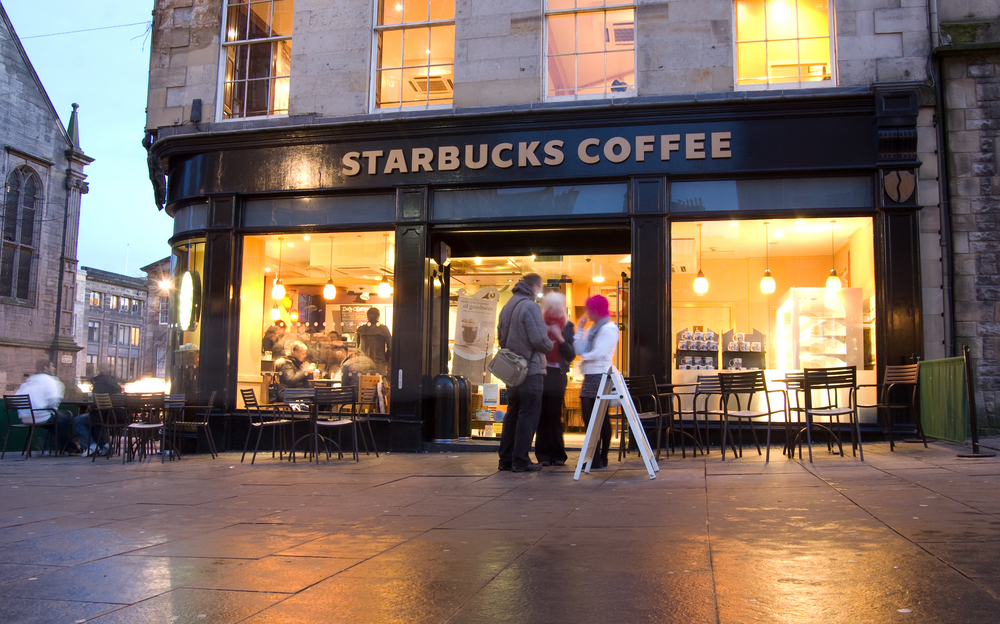
The coffee was brewing as usual, and patrons were as caffeine-crazed as any other day, but something curious was happening behind the scenes at beloved and bemoaned coffee giant Starbucks on March 9, 2012.
On that date, Adam Brotman, formerly senior vice president of Starbucks Digital Ventures, was named to an entirely new executive role, chief digital officer. With the creation of the CDO role, all of Starbuck’s digital projects — web, mobile, social media, digital marketing, Starbucks Card and loyalty, e-commerce, Wi-Fi, Starbucks Digital Network, and emerging in-store technologies — were packaged together and placed under Brotman’s care.
Not just another executive promotion, the move signaled something bigger and far more profound: Starbucks is turning into a tech company.
Seismic shift

Above: Adam Brotman, Chief Digital Officer, Starbucks
The way Brotman explained it to me in an exclusive interview, Starbuck’s digital businesses are as essential to the company’s ongoing success as the coffee it sells.
“[Digital] has been an essential part of how we build our brand and connect with our customers… there’s been such a seismic shift [in our interactions with customers] that we needed to pull it all together and make it a priority,” Brotman said.
To understand why, you’ll have to go back to the past. The Starbucks of 10 years ago built its brand and told its story almost exclusively through its employees (“partners,” in company parlance). Smiling faces in green aprons were largely responsible for your impression of the company and its mission.
Today, baristas remain core to the in-store experience, but the company can use its arsenal of digital tools to build even more lasting relationships with customers. With 18,000 stores in 58 countries and an expanded portfolio of products, Starbucks is relying on digital to help spur even more growth.
“Digital has to help our store partners and help the company be the way we can tell our story, build our brand, and have a relationship with our customers,” Brotman said.
The digital restructuring, championed by chief executive Howard Schultz, has been four years in making, Brotman said. The radical move to create a chief digital officer position is soon to be copied by the biggest and brightest brands.
“It’s reflective of a trend that we’re going to see happen at Fortune 500 companies around the world,” Brian Solis, principal at Altimeter Group, told VentureBeat of the CDO role.
“We live in an era where the customer landscape is not only dynamic, it’s incredibly segmented,” Solis said. “What used to work from a traditional marketing sense … now opens up a series of new touch points that we have to explore.”
By creating the chief digital officer role, Starbucks is on the right track and demonstrating that it’s thinking about the customer and the business in more fluid ways, Solis said.
“Now they’re looking at people that are increasingly mobile, increasingly social. And what [Brotman’s] going to learn, and what other CDOs are going to learn, is that what it comes down to is the experience,” Solis said. “How do you connect with somebody who is living in the app economy? How do you connect with somebody who lives within the social graph? Are they similar or are they dissimilar? What’s it going to take to cultivate those types of relationships?”
Solis also pointed to makeup retailer Sephora as another brand deeply committed to digital in all the right ways. The company, recognizing that consumers’ shopping behaviors have changed, is putting iPads in stores, equipping stores with Wi-Fi, and is actively encouraging customers to shop and search online as part of the in-store, decision-making process.
“The reason why Starbucks and Sephora are investing heavily on these digital strategies, and these roles to support these digital strategies, is because it’s not just any one type of initiative that’s going to grow their customer base,” Solis said. “It takes a series of complimentary and parallel strategies that someone has to orchestrate.”
Mobile pay the simple way
One of Starbucks’ digital means for customer engagement is a mobile payment system that’s years ahead of the curve in terms of adoption.
While big-gun technology and payments companies worked on grandiose near-field communication (NFC) solutions, Starbucks shipped a basic, 2-D barcode-scanning system, built into its iPhone and Android apps. Essentially, it lets you carry your Starbucks card in your phone.
The payment system debuted in January 2011 and customers seem to love it. As of April, Starbucks had processed more than 45 million mobile payments.
Brotman wouldn’t reveal the inner workings of Starbucks’ emerging in-store technologies group, the team responsible for the technology behind mobile pay, but did hint that this lab, the company’s R&D hub, would be responsible for expanding payments technology and coming up with digital creations that highly localize the in-store experience.
A social trailblazer
In social media land, Starbucks has become the archetype of the savvy brand.
“We’re trying to be incredibly good at listening and data mining,” said Brotman of Starbucks’ approach to social media. “We can listen to our customers digitally, globally, and gain insights … it helps with authenticity.”
Hip to Twitter before it was cool, Starbucks now has a loyal following of 2.5 million people and has been known to run a promotion or two through the information network. There are also more than 30 million Facebook users who “like” the company on the world’s biggest social network and happily engage with Starbucks status updates.
Facebook has proved such a powerful medium for spreading the word about campaigns that Brotman refers to the relationship between the coffee company and the social network as a “partnership.” Starbucks has no qualms about spending on Facebook advertisements, Brotman said, though the company does put a lot of thought into its promoted media strategy.
The brand was quick on the Instagram bandwagon, too, and continues to interact with customers through the photo-sharing service (which is now part of Facebook).
“We want to meet our customers where they are, and Instagram is a great example of that … we were invited in [to the community] by customers,” Brotman said.
“Instagram continues to be a strong and growing community for Starbucks,” a company spokesperson added, pointing to the 173 photos the brand has posted and the more than 600,000 user photos with the #starbucks tag.
Not a brand to sit back and watch as trends take shape, Starbucks is, of course, also on Pinterest. The company set up shop there in late April and has a growing following.
If goodwill is what you want, Starbucks uses its digital channels to sell that too. A fresh partnership with (RED) and Foursquare which saw Starbucks donating $250,000, $1 for every check-in, to fight AIDS.
Then there’s the partnership with Google, which saw the companies raising money to create jobs. Starbucks ran a sold-out Google Offer of $5 for $10 worth of store credit at Starbucks. Google donated $3 for every activated offer to Starbucks’ Create Jobs for USA initiative. The promotion was Starbucks’ first daily deal and was dreamt up as more of a means to give back to small business than a way to bring in new business. The campaign, in combination with a Banana Republic fundraising initiative, contributed more than $2 million to the jobs fund.
The digital connection

As a brand that people both love and love to hate, Starbucks has taken over web, mobile, and in-store domains with such digital force that it drowns out the voice of its most vocal detractors.
The company even continues to offer compelling digital freebies to keep its occasional patrons happy: completely free Wi-Fi and a smattering of premium content through Starbucks Digital Network.
Long past its cool prime and far too large to be hip, Starbucks, by going all-in on digital, gets insight into the wants and needs of today’s connected consumers in a way that keeps the brand top of mind. What we have, then, is a technology-steeped version of Starbucks that’s equal parts power retailer and innovator.
Already adept at digital, there’s no telling what a more supported digital hub inside the world’s largest coffeehouse company will brew up next.
“Right now, there’s a lot of excitement amongst combined digital teams for the opportunity to innovate and build upon a foundation that started with My Starbucks Idea and exploded through social media,” Brotman said. “The true opportunity is in how we combine all these things. One group … one direction.”
Photo credit: Brendan Howard / Shutterstock.com
VentureBeat's mission is to be a digital town square for technical decision-makers to gain knowledge about transformative enterprise technology and transact. Learn More

